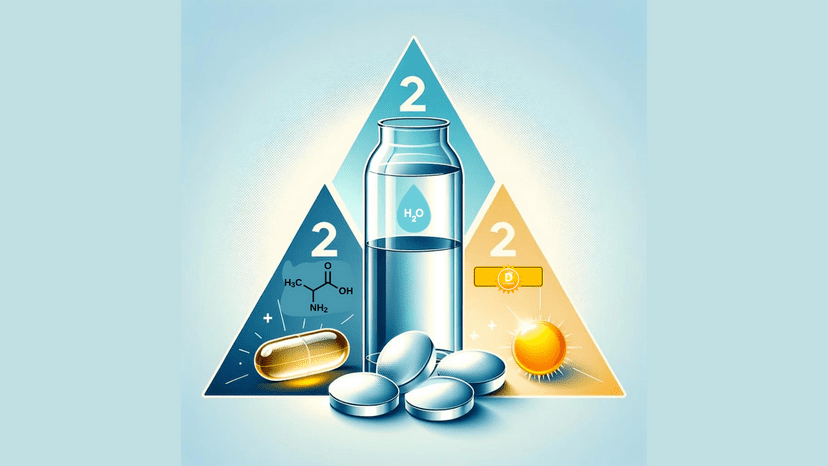How to Lose Weight When Injured and Can't Exercise

Adjusting Your Diet for Weight Loss
When physical challenges or injuries prevent you from engaging in your regular workout routines, diet plays a pivotal role in controlling and maintaining your weight. It's essential to understand that a healthy diet is not simply about restricting what you eat, but more about eating the right foods and in the right proportion.
Creating a Calorie Deficit without Exercise
Our bodies consume a certain amount of calories every day, even when not exercising. This is because our cells need energy to carry out routine functions like digestion, circulation, and cell repair. This is known as our [Basal Metabolic Rate (BMR)](/glossary/health/basal-metabolic-rate). To create a calorie deficit, the first step is to calculate your BMR which can be done using various online calculators or can be provided by a dietitian. Once you know your BMR, you can plan your diet so that you consume fewer calories than your BMR.
For example, if your BMR tells you your body needs 2,000 calories a day, you can plan your meals in a way that you consume only 1,500 or 1,800 calories. This creates a caloric deficit which means your body will start using the stored fat to meet its energy needs, leading to weight loss.
Remember, the key is to reduce your calories slowly and not go below the minimum required intake, which usually is 1,200 calories for women and 1,500 calories for men.
Nutrient-Dense Foods for Satiety and Health
Even while creating a calorie deficit, it's important to ensure your diet is still nutrient-rich. This is where nutrient-dense foods come into play. They provide you with nutrients like proteins, vitamins, and minerals ensuring your body functions optimally even on fewer calories.
Whole grains, lean proteins like chicken or tofu, fruits, vegetables - these are all examples of nutrient-dense foods. They not only provide essential nutrients but are also rich in fiber which keeps you feeling fuller for longer, further helping you control your caloric intake.
Having a bulk of your meals consist of these foods will not just promote weight loss, but also better overall health.
Managing Portions and Controlling Cravings
Portion control is crucial in maintaining a caloric deficit. Yet, it doesn't mean you have to starve yourself or entirely cut out the foods you love. Even so-called 'unhealthy' foods can have a place in your diet, as long as they are enjoyed in moderation and alongside nutrient-dense foods.
To manage portion sizes:
- Use smaller plates, bowls, and glasses
- Fill half your plate with vegetables or salad
- Limit high-calorie foods to a small part of your plate
As for controlling cravings, it's important to understand that denying cravings may cause an overeating spree later on. Instead of strictly avoiding the foods you love, find a healthier alternative or portion them out in a way you can still enjoy them without overeating.
Remember, consistency and patience are critical when it comes to weight loss. It may take time, but persevering through the process will result in lasting and sustainable weight loss even when you can't exercise. Weight loss is achievable, even through injury, by focusing on maintaining a balanced, nutrient-rich diet with moderate and mindful eating habits.
In adjusting your diet in this way, you not only enhance your chances of weight loss but also elevate your overall health and wellbeing. This broad perspective links weight management with a better quality of life, demonstrating that good dietary habits are not a short-term solution, but a long-term, sustainable practice.
Incorporating Low-Impact Activities
When injured, the natural knee-jerk reaction is often to cease all forms of physical activity. However, this blanket approach isn't conducive to overall health or indeed, weight loss. Contrary to common perception, incorporating safe and low-impact activities can be integral to injury recovery and maintaining a healthy weight.
Identifying Safe Activities for Your Injury Type
The type of low-impact activities you choose will heavily depend on the nature of your injury. Consulting with a healthcare provider is paramount to understand what movements will aid your recovery and what may hinder it.
For a lower body injury, upper body and core-focused activities such as seated workouts or chair aerobics might be suitable. Conversely, if you're recovering from an upper body injury, exercises like walking or lower body strength exercises could be beneficial.
For those with spinal injuries, low-impact activities suggested by a healthcare provider must be strictly adhered to prevent exacerbating the issue. This might include gentle stretching, yoga postures, or swimming.
The Role of Physical Therapy in Recovery
Physical therapy or physiotherapy is often a critical component of injury recovery. A qualified physiotherapist can suggest specific exercises that target your injured area and promote healing while enhancing strength, flexibility, and overall mobility.
In addition, they can propose a routine of safe, low-impact exercises that can stimulate weight loss without jeopardizing your injury's recovery process. This individualized exercise routine is tailored to your unique injury and recovery speed, promoting gradual weight loss while prioritizing safety.
Gentle Movement and Stretching
When you're injured, even the most basic movements can seem daunting. However, it's crucial to maintain some level of physical activity, like gentle movement and stretching, to prevent unnecessary stiffness and muscle loss.
Again, the type of stretching and gentle movement you should incorporate heavily depends on your injury type. However, some universally beneficial practices include breathwork, progressive muscle relaxation, and gentle range-of-motion exercises.
The key is to listen to your body and work within your comfort boundaries. Pain is a clear signal to ease off. It's not about pushing your limits but rather nurturing your body through the recovery process while maintaining a healthy weight.
Remember, injury recovery is unique to each individual. It's always essential to liaise closely with your healthcare provider or physiotherapist before attempting any new activities or exercises during recovery.
Incidentally, weight loss when injured isn't about rapid results. Instead, consider it a journey of balance – healing your body while maintaining a healthy weight through moderate and feasible lifestyle changes.
Focusing on Overall Well-being
The holistic approach to weight loss and health is one that encompasses the well-being of your mind, body, and spirit. When your physical activity is limited due to injury, the importance of this integrative health approach becomes even more critical. Weight loss during injury recovery isn't just about reducing numbers on the scale, it also involves taking care of your overall well-being.
Mental Health and Emotional Well-being
The power of the mind in recovery and weight loss can't be overstressed. Injury can often lead to feelings of frustration, stress, and low self-esteem, all of which can be deterrents to weight loss. In such cases, it becomes very important to ensure your mental health and emotional well-being are well addressed.
Impart positivity into your daily routine by cultivating a positive mindset toward your situation. Acknowledge your feelings but don't let them consume you. Take a few minutes each day to center and calm your mind. You could engage in mindfulness techniques, meditation, or even simple breathing exercises.
As you focus on mental health, remember that your injury is temporary. Shift your mental outlook to weight loss to more long-term, sustainable goals.
Improving Sleep for Recovery and Weight Loss
Optimizing sleep is an often-ignored, yet crucial component of weight loss and recovery. High-quality sleep plays a critical role in hormonal regulation, tissue healing, and overall well-being. These factors are especially essential when you are injured and aiming for weight loss.
Develop a consistent sleep schedule that ensures you get a minimum of 7-9 hours of sleep. Create a restful environment and limit exposure to screens at least one hour before bedtime. These habits collectively contribute to improving sleep and in turn, support weight loss and faster recovery.
Stress Management Techniques
When going through an injury, it's normal to experience higher levels of stress. It's crucial to implement effective stress management techniques to support your weight loss goal during this period. Chronic stress can lead to weight gain by promoting unhealthy eating habits, and it can interfere with recovery by impacting sleep and overall well-being.
To counter stress, try different relaxation techniques such as deep breathing, progressive muscle relaxation, and guided imagery. If possible, get involved in low-impact activities like walking, swimming, or gentle yoga (always ask your health-care provider before starting any exercise regimen). Don't underestimate the power of social interactions. Reach out to loved ones or consider joining support groups.
Remember that being patient and gentle with yourself is vital throughout this period. While sustained weight loss might seem challenging with injury, focusing on overall well-being will ensure that you not only lose weight but maintain your health in the long run. With the right mindset and integrated strategies, your journey to well-being and weight loss, even in the face of adversity such as injury, can surely be successful and fulfilling.
In Summary
In conclusion, we've learned in this blog that weight loss and health maintenance are indeed possible even when physical activities are limited due to injury. It's important to put the right strategies in place to ensure that the process is sustainable and health-enhancing.
-
Understanding the key role of diet: Our diet plays an important role in weight control, and by creating a caloric deficit, we can stimulate weight loss even without intensive physical exercise. Consuming nutrient-dense foods and practicing portion control can help maintain our health and weight during injury recovery.
-
Incorporation of low-impact activities: We can still engage in low-impact activities, appropriate to our specific injury, to support overall health and facilitate weight loss. This involves consulting with healthcare providers and possibly employing physiotherapy exercises done safely according to professional advice.
-
Prioritizing overall well-being: It's important not to overlook mental health aspects of recovery, while aiming for weight loss. Implement strategies to improve mental health and emotional well-being, prioritize improving sleep, and use stress management techniques to aid recovery and promote renewed health.
To turn this advice into action, consider the following steps:
- Calculate your BMR using an online calculator or seek professional guidance.
- Create a meal plan that places your caloric intake below your BMR.
- Incorporate nutrient-dense foods into your diet and practice portion control.
- Consult with a healthcare provider on the low-impact physical activities you can engage in for your specific type of injury.
- Maintain consistent and appropriate physical movement in line with professional advice.
- Address any emotional or mental health concerns and create a regular schedule for stress management, sleep and relaxation techniques.
- Be patient and consistent in maintaining your diet, exercise and mental health regimes.
The journey to recovery and weight loss through injury may be challenging, but by considering these action steps and maintaining a holistic approach, optimal health is within reach.





